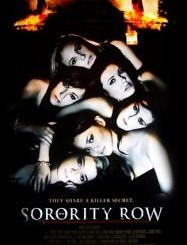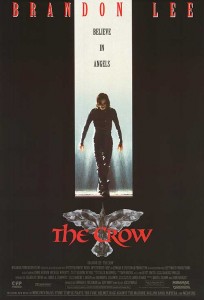 In a multi-part series, Comic Book Film Editor William Gatevackes will be tracing the history of comic book movies from the earliest days of the film serials to today’s big blockbusters and beyond. Along with the history lesson, Bill will be covering some of the most prominent comic book films over the years and why they were so special. This time, we’ll look at the tragic comic book film that adapted a tragic comic book—The Crow.
In a multi-part series, Comic Book Film Editor William Gatevackes will be tracing the history of comic book movies from the earliest days of the film serials to today’s big blockbusters and beyond. Along with the history lesson, Bill will be covering some of the most prominent comic book films over the years and why they were so special. This time, we’ll look at the tragic comic book film that adapted a tragic comic book—The Crow.
The biggest thing that the comic book The Crow had in common with its film adaptation is the role tragedy played in the making of each of them. James O’Barr wrote and drew the first Crow miniseries as a way to escape the pain caused by his fiancée’s death, and The Crow film had a macabre shadow cast over it by the untimely death of its star, Brandon Lee, during production.
James and Beverly Ann were high school sweethearts that knew, even at that very young age, that they wanted to spend the rest of their lives together. They became engaged to be married, a wedding that would come after they graduated high school.
That wedding would never come. Beverly Ann was killed by a drunk driver shortly before that anticipated graduation, in early 1978. As is often the case with young love, James had a hard time dealing with the loss. He enlisted in the Marines, hoping the stability of the military would take his mind off Beverly Ann. It didn’t. Seeking solace, he decided to put pen to paper. While stationed with the Marines in Germany, while working as an illustrator of military manuals, he read an article about a couple from his hometown of Detroit that were killed over a $20 engagement ring. Seeing a corollary between that tragic event and his own, he used it in 1981 as the framework for an origin story in a comic book that he hoped would allow him a cathartic release from his own pain and sadness.
 The James in question is James O’Barr and that comic book is, of course, The Crow.
The James in question is James O’Barr and that comic book is, of course, The Crow.
The original comic focused on Eric and his fiancée, Shelly. Just before they are about to be married, their car breaks down in a bad part of town. A drug-addled street gang comes across them and decides to have a little fun. They shoot Eric in the head while they brutally rape and beat Shelly. The gunshot leaves Eric paralyzed and dying, able to watch the torture Shelly is going through yet helpless to stop it. The gang leaves them by the side of the road, where they each die from their injuries.
One year later, a mystical crow resurrects Eric and offers him the chance at vengeance. Wearing harlequin makeup and dressed in black, Eric dubs himself The Crow, and begins the process of hunting down the gang members that killed him and Shelly.
You don’t have to be a psychologist to see what O’Barr was doing with this comic. There is anger, pain and sadness on every page. You can easily see the parallels between O’Barr’s life and Eric’s. Both lost the woman they loved in a senseless act of violence. Only O’Barr gives Eric a number of culprits to take out his anger and frustration, his sorrow and loss, on, a luxury O’Barr never had for himself.
 Being that The Crow was somewhat hard to pigeonhole—too violent to be a gothic tale of revenge, too literate and morose to be your typical superhero comic—O’Barr had a hard time finding a publisher. It wasn’t until 1989, eight years after O’Barr started the comic, that Caliber Comics decided to put the book out.
Being that The Crow was somewhat hard to pigeonhole—too violent to be a gothic tale of revenge, too literate and morose to be your typical superhero comic—O’Barr had a hard time finding a publisher. It wasn’t until 1989, eight years after O’Barr started the comic, that Caliber Comics decided to put the book out.
The book was a cult hit. What Caliber, and later Tundra, Kitchen Sink, Image and IDW, realized that the other publishers didn’t was that there was something in The Crow that would resonate with readers beyond just a genre. The story was a doomed romance. It was about the pain of losing someone you cared about. It was anger at what was taken from you and the wish fulfillment of striking back at those who had hurt you the most. These qualities are more prevalent amongst people than one might care to admit, and O’Barr had given them all a voice.

With the successful cult comic came Hollywood offers. O’Barr sold the rights to four movies to Ed Pressman and Jeff Most. At first, the creator and the producers weren’t on the same page at all. At an early production meeting with movie executives, O’Barr was presented with their ideas for the film—one of which was a musical adaptation starring Michael Jackson. While the powers that be moved away from that horrible concept, the first few scripts that came in bore no resemblance to the comic at all. Things didn’t start turning around until director Alex Proyas and Brandon Lee came on board.
O’Barr originally had reservations about Lee’s casting, believing that it was another sign that the producers had no idea as to what to do with his comic book. Since Lee was Bruce Lee’s son and had starred in films like Showdown in Little Tokyo and Rapid Fire, two martial arts-ish action films, O’Barr thought The Crow was headed in the same direction. But Lee impressed the Crow’s creator by studying the original comics to such a point that the actor could quote lines from it back to O’Barr.
 The Crow was a risky venture for Brandon Lee, one he really didn’t need to take. His name and parentage could garner him a career in the martial arts action film with little or no effort. But his charm, charisma and talent allowed him to make the most of his opportunities. If he stayed in the B-level action film, he could have a long and productive career, whether in the smaller low-budget films (like Dolph Lundgren and Michael Dudikoff), big budget blockbusters (like Arnold Schwarzenegger or Bruce Willis) or somewhere in between (like Steven Segal and Chuck Norris).
The Crow was a risky venture for Brandon Lee, one he really didn’t need to take. His name and parentage could garner him a career in the martial arts action film with little or no effort. But his charm, charisma and talent allowed him to make the most of his opportunities. If he stayed in the B-level action film, he could have a long and productive career, whether in the smaller low-budget films (like Dolph Lundgren and Michael Dudikoff), big budget blockbusters (like Arnold Schwarzenegger or Bruce Willis) or somewhere in between (like Steven Segal and Chuck Norris).
But Lee was trained as an actor at the Lee Strasberg Theatre and Film Institute. He wanted a role that was more of a challenge, and the role of Eric Draven would give him just that. And his performance in the film very well could have propelled him to superstardom if tragedy didn’t strike.
Proyas and the crew scheduled all of the non-Crow parts of the movie, including Eric’s death, until the last few weeks of production to allow Brandon to have the last days of shooting be makeup free. One of the first scenes to be shot during this period, just 8 days before shooting was to wrap and three weeks before Lee was set to marry his fiancé, Eliza Hutton, was Eric’s murder. In a change from the comic, Funboy (Michael Massee) and his gang attack and kill Eric and Shelley in their home, acting on orders from their boss, Top Dollar (Michael Wincott). Massee was supposed to shoot Lee with a gun full of blanks just as he got back from a grocery run. And that’s what he did, with one horrible, fatal problem.

The gun Massee used was in a scene shot earlier that was to show it being loaded. Typically, dummy rounds are used in these types of scenes, as they look exactly like real rounds only with no primer, propellant or explosive charge. They have a bullet at the end of the round but there is no way for it to be fired because it is inert. For this scene, due to budgetary and time constraints and the fact that they were filming in North Carolina instead of Hollywood, the crew didn’t have access to dummy rounds. They instead jury rigged live rounds by removing the explosive charge and propellant. However, they left the primer in. If fired, there would not be enough force to have the bullet leave the barrel, but there would be enough force to lodge it in the barrel.
And that was what happened. At some point between the loading scene and Eric’s murder scene, while the modified rounds were still in the gun, someone pulled the trigger, which caused the bullet to get stuck in the barrel. Blanks consist of rounds that have primer, propellant and explosive charge held in by a wad of wax, wood or cotton, but no bullet. This is designed to give a realistic muzzle flash. As long as the blank is fired from a safe distance, they are harmless. But, due to the fact that they have the same firing power as a real round, if the blank is fired at a close enough distance, it could be fatal (as is what happened to Jon-Eric Hexum on the set of the TV series Cover Up, who, as a joke, held a gun containing blanks up to his temple and fired. The wad hit Hexum’s skull with enough power to send parts of his skull into his brain, resulting in brain death). And if there was a bullet lodged in the barrel, the round would then become essentially live ammunition.
When Massee fired the blank at Lee, it propelled the bullet in the barrel into Lee’s abdomen. The bullet perforated many of Lee’s internal organs, including his stomach, and ruptured a major artery, causing massive internal bleeding before lodging in his spine. It has been said that even if the accident took place in the emergency room of a hospital, there would have been no way to save Lee. Lee was pronounced dead at 1:04 pm on March 31, 1993. He was 28 years old.
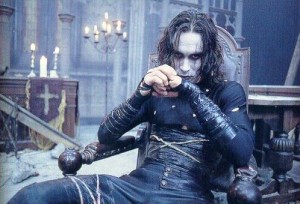 Brandon Lee’s death would have been tragic under any circumstances. If the firearms expert had been there, he would have checked the barrel. If Massee aimed just a few inches to the right, this would have been avoided. Add to the fact that his father died at the age of 32 and his death has been the focus of a number of conspiracy theories (Killed by the Triads? A supernatural curse?) and the accident that killed Brandon took on an entirely different dimension. Add to that the fact that Brandon was killed while filming his character’s death and his character was set to marry his true love if he wasn’t killed, and Brandon’s death becomes all the more unusual.
Brandon Lee’s death would have been tragic under any circumstances. If the firearms expert had been there, he would have checked the barrel. If Massee aimed just a few inches to the right, this would have been avoided. Add to the fact that his father died at the age of 32 and his death has been the focus of a number of conspiracy theories (Killed by the Triads? A supernatural curse?) and the accident that killed Brandon took on an entirely different dimension. Add to that the fact that Brandon was killed while filming his character’s death and his character was set to marry his true love if he wasn’t killed, and Brandon’s death becomes all the more unusual.
Brandon Lee’s death, as horrible and as callous as I feel saying it, makes The Crow a better film. The fact that you are watching the best performance Brandon Lee ever made as the last performance he ever made adds an almost unbearable sense of melancholy to the film. And since the story is melancholic to begin with, the tragedy enhances the mood of the film. The sadness I feel for Brandon Lee’s death parallels the sadness his character, Eric Draven, is experiencing on screen, therefore it’s easier to get drawn into the film. The tragedy transforms the film into an entirely different experience. I don’t know if the film would have been as successful, either critically or financially, if Brandon Lee survived the process.
But since the film was a success and the producers had the option for three sequels if they chose, they went into production on a follow up, 1996’s The Crow: City of Angels.
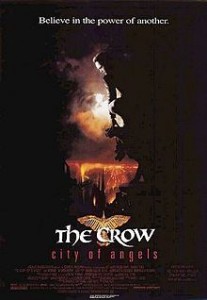 Director Tim Pope (known mostly for his music videos) and writer David S. Goyer (writing the first of what would be many comic book adaptations) fought with Miramax over the tone of the film, Pope and Goyer wishing to honor Lee by making the film as different as can be, Miramax wanting characters from the first film such as Sarah and the resurrected Top Dollar, to be included in the sequel. Pope and Goyer included Sarah as a peace offering, but lost out in the end as the studio recut the finished film after the fact to make it more tonally similar to the first film. If continuing with production on The Crow was a tribute to Brandon Lee, what Miramax did with this film is the equivalent of grave robbing.
Director Tim Pope (known mostly for his music videos) and writer David S. Goyer (writing the first of what would be many comic book adaptations) fought with Miramax over the tone of the film, Pope and Goyer wishing to honor Lee by making the film as different as can be, Miramax wanting characters from the first film such as Sarah and the resurrected Top Dollar, to be included in the sequel. Pope and Goyer included Sarah as a peace offering, but lost out in the end as the studio recut the finished film after the fact to make it more tonally similar to the first film. If continuing with production on The Crow was a tribute to Brandon Lee, what Miramax did with this film is the equivalent of grave robbing.
After that, the law of diminishing returns came into effect. There would be two more sequels: 2000’s The Crow: Salvation in which an executed convict falsely convicted of killing his girlfriend comes back as the Crow, and 2005’s The Crow: Wicked Prayer, which featured a Native American ex-con who is killed along with his girlfriend by Satanists only to come back for revenge. Neither film got much, if any, of a theatrical release and both have been widely panned by critics.
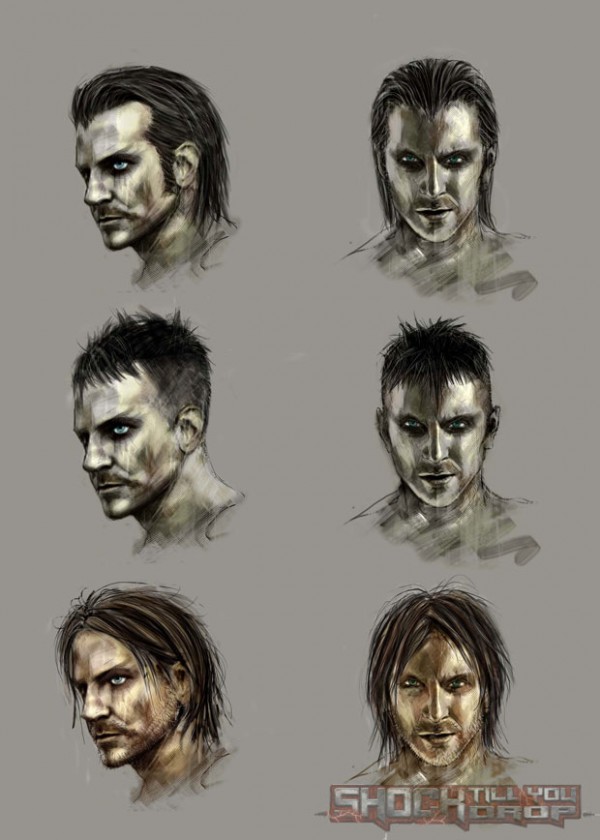 A remake of the first Crow film has been in the works since 2007, with Stephen Norrington originally attached to direct, later to be replaced by 28 Weeks Later’s Juan Carlos Fresnadillo. Bradley Cooper was rumored to be in talks for the lead, but the project appears to be headed towards legal wrangling between current production company holders Relativity and distributors The Weinstein Group over who has the rights to distribute the movie. Tying the remake up in legal red tape might be the best thing to happen to it.
A remake of the first Crow film has been in the works since 2007, with Stephen Norrington originally attached to direct, later to be replaced by 28 Weeks Later’s Juan Carlos Fresnadillo. Bradley Cooper was rumored to be in talks for the lead, but the project appears to be headed towards legal wrangling between current production company holders Relativity and distributors The Weinstein Group over who has the rights to distribute the movie. Tying the remake up in legal red tape might be the best thing to happen to it.
Next, things get a little lighter as we cover Jim Carrey’s first, and best, foray into portraying a comic book character.




